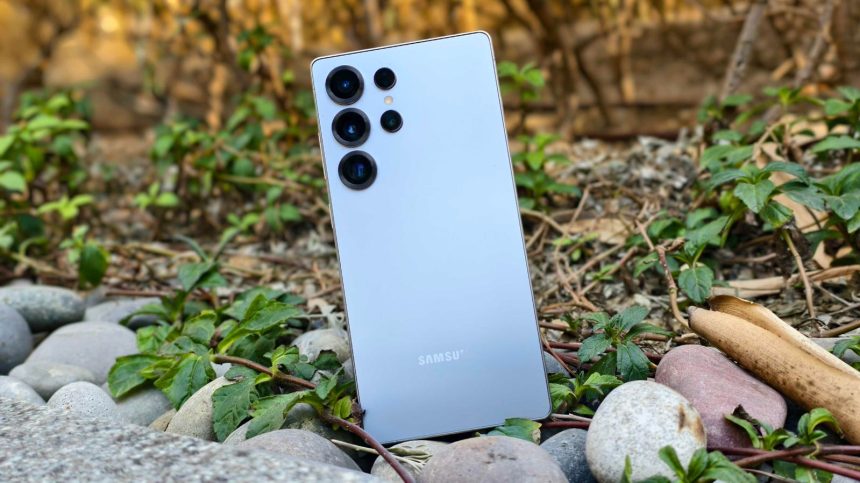The Samsung Galaxy S25 Ultra, while boasting impressive features, represents a shift in Samsung’s strategy, prioritizing AI enhancements over substantial hardware upgrades. This approach results in a device that feels more like a refined iteration of its predecessor rather than a groundbreaking leap forward. While the phone excels in certain areas like display quality and battery life, the over-reliance on still-developing AI features and the lack of significant hardware advancements raise questions about its “Ultra” status and overall value proposition.
The S25 Ultra’s design, while lighter than the S24 Ultra, introduces a new ergonomic challenge. The combination of rounded corners with flat sides and sharp edges creates an uncomfortable grip for some users, particularly those who hold their phones with their pinky finger supporting the bottom. This design quirk can lead to finger and wrist pain after extended use, necessitating the use of a case for a more comfortable hold. Counterbalancing this design flaw is a stunning 6.9-inch AMOLED display, arguably the best on the market. With slimmer bezels, a dynamic refresh rate, and impressive brightness, the display offers a superb viewing experience, enhanced further by the improved anti-reflective coating of Gorilla Armor 2.
Samsung’s bold gamble on AI as the S25 Ultra’s differentiating feature is a double-edged sword. While features like AI Select, which suggests on-device actions based on selected screen content, offer genuine usability improvements, other AI implementations remain inconsistent and underdeveloped. The Now Bar, inspired by Apple’s Dynamic Island, is currently limited in functionality, and Now Brief, designed to consolidate relevant information, often fails to deliver on its promise. Similarly, while features like transcription assist and object generation within photos demonstrate the potential of AI, their performance is often unreliable. The introduction of Gemini, replacing Bixby, shows promise for cross-app functionality, but its execution is still flawed, often failing to perform simple tasks reliably. While Samsung’s AI capabilities have progressed, their current state feels more like a work in progress than a finished product, unsuitable for being a flagship feature.
The hardware aspects of the S25 Ultra largely mirror its predecessor. The same storage and RAM configurations, primary and telephoto cameras, battery capacity, and charging speeds are carried over, relying on the new Snapdragon 8 Elite SoC for performance and efficiency gains. While the new chipset delivers smooth performance and improved battery life, it doesn’t represent a substantial leap forward. The S Pen, a hallmark of the Ultra series, has seen a feature downgrade with the removal of Bluetooth functionality, a decision justified by Samsung based on low usage statistics, but disappointing for those who valued its remote control capabilities.
Camera improvements are incremental, focusing on an upgraded 50MP ultrawide-angle lens. While the ultrawide camera delivers better detail and edge performance, overall image quality remains characteristically Samsung, with vibrant colors, good dynamic range, and a tendency towards blurry images of moving subjects. Although the Expert RAW app offers manual adjustments to address this, it adds an extra layer of complexity for casual users. Additional features like log video recording, improved low-light video processing, and an Audio Eraser function cater to content creators, but the Audio Eraser’s performance can result in unnatural-sounding audio.
The Galaxy S25 Ultra, priced at a premium, faces a challenging value proposition. While it offers an exceptional display, smooth performance, and all-day battery life, its “Ultra” status feels diminished by the lack of significant hardware upgrades. The reliance on still-maturing AI features and the removal of S Pen functionality further contribute to this perception. The S25 Ultra remains a compelling option for business professionals who value productivity on the go, thanks to the S Pen and One UI, but it lacks the innovative edge that previously defined the Ultra series.
In conclusion, the Samsung Galaxy S25 Ultra embodies a transitionary phase for Samsung. It highlights the brand’s focus on software-driven innovation through AI, but the execution falls short of expectations. While offering incremental improvements in certain areas, the lack of significant hardware advancements and the reliance on still-developing AI features raise questions about its value proposition compared to its predecessor and its competitors. The S25 Ultra serves as a testament to Samsung’s ongoing exploration of AI’s potential in mobile technology, but it also underscores the need for more refined and reliable AI implementations before they can truly become the defining feature of a flagship device. For those seeking cutting-edge hardware and truly revolutionary features, the S25 Ultra might feel more evolutionary than revolutionary.



